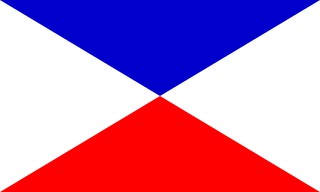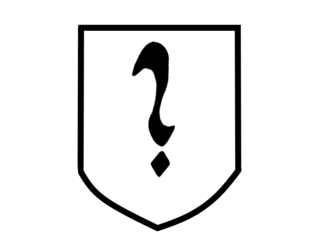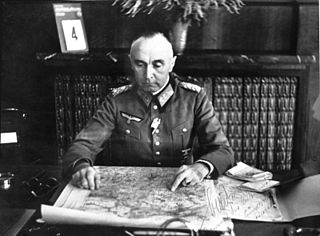Operational history
The 167th Infantry Division was formed in the Bavarian capital of Munich in November 1939, absorbing the 7th; 27th and 34th Field-Replacement Battalions from their respective divisions in January. It was also at this point that its commanding officer, Colonel Gilbert, was promoted to major general, shortly before his replacement by Lieutenant General Oskar Vogl. [1]
The division took part in the initial 1940 invasion of France with Army Group C, capturing Ouvrage Kerfent and Ouvrage Bambesch - two components of the Maginot Line - between 20–21 June. [2] The division remained in occupied France until February 1941, when it returned to its garrison in Bavaria. In August 1940, Major General Hans Schönhärl took over as commanding officer, being promoted to lieutenant general in December.
Barbarossa and the Soviet Union
In June 1941, the division was transferred to the occupied Polish capital of Warsaw as the Axis forces began their assault on the Soviet Union in Operation Barbarossa. In August, Schönhärl was replaced as commanding officer by Major General Verner Schartow, himself replaced by Major General Wolf Trierenberg. On December 17, Red Army forces succeeded in punching a hole in the 167th's sector, only to be forced back by support from the 112th Infantry, with some tank support. [3]
Later the Division took part in the Battle of Moscow, Battle of Kursk, and finally against the Dnieper–Carpathian Offensive, where the 167th Infantry Division was disbanded due to heavy losses in January 1944.
The re-created division, now designated 167. Volksgrenadierdivision, took part in the Ardennes Offensive. On New Years Day, it, along with the 5th Parachute Division, aided the panzers in defending the area around the Belgian town of Lutrebois in Luxembourg. While the three were able to hold off the approaching Americans and dealt heavy casualties to their enemies, the situation elsewhere in the Ardennes was different and the 167th was ordered to fall back. [4]

The 16th Infantry Division of the German Army was formed in 1934. On 26 August 1939 the division was mobilized for the invasion of Poland (1939). It participated in the Battle of France in August 1940. The division was then split, resulting in two independent units: The 16th Panzer Division and the 16th Motorized Infantry Division. Then later, from 1944 onward, combined with other non 16th elements, was known as the 116th Panzer Division.
The 164th Infantry Division was an infantry division of the German Army during World War II. Formed in November 1939, the division took part in the invasion of Greece in April 1941. In January 1942, consolidating the Axis seizure of the island during the Battle of Crete, the 164th was reorganized as Fortress Division Kreta (FDK). In mid-1942 the division was transferred to North Africa and re-designated as 164th Light Afrika Division. It surrendered in May 1943 in Tunisia at the end of the North African Campaign.

The 12th Infantry Division – later known as the 12th Volksgrenadier Division – was a Wehrmacht military unit of Nazi Germany that fought during World War II. The division was formed in 1934. It participated in the invasion of Poland in 1939 and the 1940 campaign in France and the Low Countries. In the Soviet Union, the division joined Operation Barbarossa. The division was destroyed in the Soviet Operation Bagration in the summer of 1944. The division was re-activated in September 1944 and posted to the newly created Western Front.
The XXXIX Panzer Corps was a German panzer corps which saw action on the Western and Eastern Fronts during World War II.

XXXXI Panzer Corps was a Panzer (armoured) corps in the German Army during World War II.

The 56th Infantry Division was a German infantry division which fought during World War II.

Otto von Knobelsdorff was a German general during World War II who led the 19th Panzer Division and then held a series of higher commands. He was a recipient of the Knight's Cross of the Iron Cross with Oak Leaves and Swords.

The 227th Infantry Division named "Rheinisch-Westfälische" was created on 26 August 1939 in Krefeld. The division was deployed for the last time in February 1945 in the Tuchola Forest.

The 25th Infantry Division was a military unit of the German Wehrmacht. It was later reclassified to 25th Motorized Infantry Division, and in June 1943 to the 25th Panzergrenadier Division.

The 36th Infantry Division was a German infantry formation of World War II. It was formed in Kaiserslautern on 1 October 1936. During World War II it was mobilized in August 1939, as part of the first wave. It was later reorganized and re-designated the 36th Infantry Division (mot) in November 1940. It was then de-motorized, reorganized and re-designated the 36th Infantry Division on 1 May 1943. The division was destroyed at Bobruysk in June 1944 during the Soviet Operation Bagration. It was reformed on 3 August 1944 as the 36th Grenadier Division and renamed the 36th Volksgrenadier Division in October 1944.

The 82nd Infantry Division was a German Army infantry division in World War II. The 82nd was part of the sixth Aufstellungswelle of German infantry divisions.

The 24th Infantry Division was a German Army infantry division active in World War II. It served across the Eastern Front in engagements such as the Sieges of Sevastopol and the Leningrad, finally being destroyed in the Courland Pocket in 1945.

The Fortified Sector of Faulquemont was the French military organization that in 1940 controlled the section of the Maginot Line in the area of Faulquemont to the east of Metz. With five petit ouvrages the sector was poorly equipped with fortress artillery, limiting the ouvrages ability to provide mutual support. The sector was attacked in 1940 by German forces in the Battle of France. Despite the withdrawal of the mobile forces that supported the fixed fortifications, the sector mounted a strong resistance. Two of the petit ouvrages fell to German attack, the remainder holding out until the Second Armistice at Compiègne. The surviving positions and their garrisons finally surrendered on 2 June 1940. During the Cold War, Ouvrage Kerfent was partially reactivated as a communications station for Royal Canadian Air Force units stationed in northwestern France with NATO. At present, most of the underground works in the sector are flooded by groundwater. Only Ouvrage Bambesch has been preserved and may be toured by the public.

The 708th Volksgrenadier Division, formerly the 708th Infantry Division was a German army division active during World War II. It took part in Operation Northwind, where it was subsequently destroyed.
The 85th Infantry Division was a Wehrmacht division used in the Second World War. It participated in the German defence in the Battle of Normandy, and took part in the German counter-offensive in the Ardennes.

Paul Bader was a General der Artillerie of the Wehrmacht during World War II who commanded the 2nd Motorized Infantry Division in the invasions of Poland and France then served as a corps commander and as Military Commander in Serbia. During his time in occupied Yugoslavia troops under his command engaged in several major anti-Partisan operations, within both the Territory of the Military Commander in Serbia and in the Independent State of Croatia.
The XXIV Army Corps was a unit of the German Army during World War II. The unit was re-designated several times; originally being Generalkommando der Grenztruppen Saarpfalz, later Generalkommando XXIV. Armeekorps, then XXIV. Armeekorps (mot.) and finally XXIV. Panzerkorps.

The 376th Infantry Division was an infantry division of the German Army during World War II, active from 1942 to 1944 in two separate instances.
The 252nd Infantry Division was an infantry division of the German Heer during World War II.
The 253rd Infantry Division was an infantry division of the German Heer during World War II.
This page is based on this
Wikipedia article Text is available under the
CC BY-SA 4.0 license; additional terms may apply.
Images, videos and audio are available under their respective licenses.














